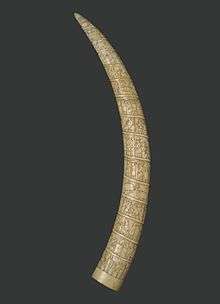Kongo ivories

Kongo ivories are some of the finest sculptural works produced by the people of the west-central Africa's Lower Congo region. In the Kongo Kingdom, ivory was a precious commodity that was strictly controlled by chiefs and kings, who commissioned sculptors to produce fine ivory sculptures for their personal and courtly use. With the rise of the transatlantic trade, ivory became one of the most valuable African natural resources sought by Western industry. Eventually, Kongo ivory carvers produced works not only for indigenous leaders and elites but also for Europeans and other foreigners.[1]
Afro-Portuguese ivories
Most of the earliest extant ivory carvings from sub-Saharan Africa were not made for African consumers.[2] Richly decorated oliphants, or side-blown horns, from the sixteenth century are among the earliest known of the Kongo Kingdom's royal commissions in ivory. Although made in the form of musical instruments to be used during court ceremonies, many such sculptures were likely given as gifts and made for sale to Portuguese elites, missionaries, and traders.[1] In the 1950s, historian William Fagg coined the term “Afro-Portuguese ivories” to describe Kongo oliphants and other ivory sculptures from this period.[3][4] A significant number of Afro-Portuguese ivories are in the British Museum, many of them made in Sierra Leone and Benin in the 15th and 16th centuries.[5][6]
Carved ivories for export
About the middle of the nineteenth century, a new style of ivory carving developed in the area to meet the demand of the export trade along the Loango Coast of west-central Africa. This style consisted of fine, detailed relief carving that depicts scenes of Kongo life.[7] Scenes commonly portrayed in relief on the ivories capture the dynamic and cosmopolitan coastal activity related to the transatlantic trade.
Most carved Loango tusks are not longer than two to three feet because they were sourced from forest elephants, which are much smaller than the African savannah elephant. Full Loango tusk sculptures that were sculpted from the enormous tusks of savannah elephants are extremely rare; one notable example is now part of the Brooklyn Museum’s collection.
References
- 1 2 Bridges, Nichole N. "Kongo Ivories". Heilbrunn Timeline of Art History. The Metropolitan Museum of Art. Retrieved 11 June 2013.
- ↑ Ross, Doran (1992). Doran Ross, ed. Elephant : the animal and its ivory in African culture. Los Angeles: Fowler Museum of Cultural History, University of California. ISBN 0930741250.
- ↑ Fagg, William (1958). Afro-Portuguese Ivories. London: Batchworth Press.
- ↑ Emma George Ross, "Afro-Portuguese Ivories" Heilbrunn Timeline of Art History. New York: The Metropolitan Museum of Art, October 2002.
- ↑ British Museum Collection
- ↑ British Museum Collection
- ↑ Siegmann, William C. (2009). African art a century at the Brooklyn Museum. Brooklyn, NY: Brooklyn Museum. ISBN 9780872731639.
External links
- For spirits and kings: African art from the Paul and Ruth Tishman collection, an exhibition catalog from The Metropolitan Museum of Art Libraries (fully available online as PDF), which contains material on Kongo ivories